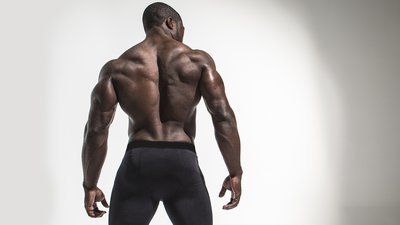If the rest of the world pursued achieving their goals with the same degree of passion and fervor that that one woman in every gym gives to building a great set of glutes, we'd end world hunger in a matter of weeks. You may have seen her: She can turn virtually every machine in the gym into a butt blaster—and does just that, as she works her glutes from every angle possible, and a few you didn't know were possible.
I'm not arguing with this woman's goals. In fact, more men should share those goals. (Seriously, dudes: biggest muscles in the body.) It's the execution that's a little overboard. No, you actually don't have to figure out how to make a Nautilus pull-over machine function as a glute machine to build a mean set of glutes. You can still just use dumbbells, a barbell, and some bands to get the job done.
The movements listed here can be done right in your home gym, so long as it is equipped with a barbell, a bench, some adjustable dumbbells, and resistance bands. Or, you can bring these ideas to the gym with you, and you'll never have to wait in line for a hamstring curl machine or kick-back station again.
1. Dumbbell Glute Kick-back
This is simple, primitive, and seriously effective. It's also a case where the cheap DIY version of a movement is better than the expensive machine it's mimicking.
With the kick-back machine, a lot of people actually have trouble feeling their glutes do the work because they often initiate the movement by extending the knee—which is a quadriceps movement. Soon enough, this move is more like a reverse leg press movement than a glute-dominant one.
With the dumbbell kick-back, the knee stays in a state of flexion, because you've got a dumbbell placed in the bend of the knee and you must hold it there. This eliminates knee extension in the movement, so by default the quadriceps will never do part of the work. The other thing this does is keep the hamstrings in a static contraction, adding in some awesome hamstring work.
To do it, just place a dumbbell in the bend of your knee, and remember to flex the foot up to hold it there. Lean slightly forward and raise your foot behind you, holding the top position for a second or two before returning to the start position.
Doing 4 sets of 12-15 reps per leg will get the job done. You can start with these to get the glutes firing, or use them at the end as a finisher.
2. Glute Destroyers
There's no real name for these so I gave them one. And it's a damn good name, because these might be one of the hardest and most painful glute and hamstring movements in the history of the universe. Luckily, there are enough awesome benefits to make them worth the struggle:
- The static flexion at the knee causes the hamstrings to have constant tension on them throughout the movement.
- The static hip extension (you should be pushing your hips into the bench very hard the entire movement) is required for maximum glute contraction.
- They demand plantar flexion of the foot to hold you in place, which also eliminates calf involvement, meaning more tension for the hamstrings and glutes.
Note: To do these safely, you will need to load up a barbell heavy enough to push your feet into it so that they are stable. You don't want to go light here and have the barbell flying up in the air. Some other pointers:
- Turn your toes slightly out.
- Use a bench that is high enough so that you aren't banging your head on the floor at the bottom (that would suck), and can get a full range of motion.
- Keep your feet pressed into the barbell the entire time. This will keep steady tension on both the glutes and hamstrings.
- Hold the top position for a second before returning to the bottom.
Start with body weight on these for 4 sets of 10-15 reps, depending on how difficult they are for you. If you can bang these out for 4 sets of 15 with no problem, then hold a dumbbell or plate for extra resistance.
3. Banded Stiff-Legged Dumbbell Deadlifts
The finisher here is some good ol' heavy stiff-legged dumbbell deadlifts—with a twist, however. Wrap a resistance band around the back of your neck, and hold it under your feet.
The band eliminates the dead range of motion at the top of the movement, where the resistance curve starts to decline. This way, the glutes aren't allowed to get lazy at the end of the range of motion, and are forced to push through into hip extension against the band resistance at the top.
I like to go somewhat heavy on these even with the bands and do 3 sets of 10-12 reps, making sure to get a full range of motion.
You could stitch these together into a workout, or you could toss any of them in as a finisher after 500 walking lunges. (And before you ask, those lunges are 1-1, 2-2, 3-3, not 1, 2, 3.) If you can handle that, you'll have built a backside that'll change your lifting life.

